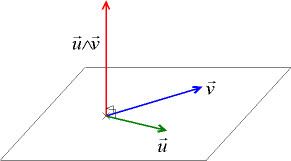 | ||
In mathematics, the structure constants or structure coefficients of an algebra over a field are used to explicitly specify the product of two basis vectors in the algebra as a linear combination. Given the structure constants, the resulting product is bilinear and can be uniquely extended to all vectors in the vector space, thus uniquely determining the product for the algebra.
Contents
Structure constants are used whenever an explicit form for the algebra must be given. Thus, they are frequently used when discussing Lie algebras in physics, as the basis vectors indicate specific directions in physical space, or correspond to specific particles. Recall that Lie algebras are algebras over a field, with the bilinear product being given by the Lie bracket or commutator.
Definition
Given a set of basis vectors
The upper and lower indices are frequently not distinguished, unless the algebra is endowed with some other structure that would require this (for example, a pseudo-Riemannian metric, on the algebra of the indefinite orthogonal group so(p,q)). That is, structure constants are often written with all-upper, or all-lower indexes. The distinction between upper and lower is then a convention, reminding the reader that lower indices behave like the components of a dual vector, i.e. are covariant under a change of basis, while upper indices are contravariant.
Example: Lie algebras
For a Lie algebra, the basis vectors are termed the generators of the algebra, and the product is given by the Lie bracket. That is, the algebra product
There is no particular need to distinguish the upper and lower indices in this case; they can be written all up or all down. In physics, it is common to use the notation
By linear extension, the structure constants completely determine the Lie brackets of all elements of the Lie algebra.
All Lie algebras satisfy the Jacobi identity. For the basis vectors, it can be written as
and this leads directly to a corresponding identity in terms of the structure constants:
The above, and the remainder of this article, make use of the Einstein summation convention for repeated indexes.
The structure constants play a role in Lie algebra representations, and in fact, give exactly the matrix elements of the adjoint representation. The Killing form and the Casimir invariant also have a particularly simple form, when written in terms of the structure constants.
The structure constants often make an appearance in the approximation to the Baker–Campbell–Hausdorff formula for the product of two elements of a Lie group. For small elements
su(2) and so(3)
The algebra su(2) of the special unitary group SU(2) is three-dimensional, with generators given by the Pauli matrices
where
In this case, the structure constants are
Doing so emphasizes that the Lie algebra su(2) of the Lie group SU(2) is isomorphic to the Lie algebra so(3) of SO(3). This brings the structure constants into line with those of the rotation group SO(3). That is, the commutator for the angular momentum operators are then commonly written as
where
are written so as to obey the right hand rule for rotations in 3-dimensional space.
The difference of the factor of 2i between these two sets of structure constants can be infuriating, as it involves some subtlety. Thus, for example, the two-dimensional complex vector space can be given a real structure. This leads to two inequivalent two-dimensional fundamental representations of su(2), which are isomorphic, but are complex conjugate representations; both, however, are considered to be real representations, precisely because they act on a space with a real structure. In the case of three dimensions, there is only one three-dimensional representation, the adjoint representation, which is a real representation; more precisely, it is the same as its dual representation, shown above. That is, one has that the transpose is minus itself:
In any case, the Lie groups are considered to be real, precisely because it is possible to write the structure constants so that they are purely real.
su(3)
A less trivial example is given by SU(3):
Its generators, T, in the defining representation, are:
where
These obey the relations
The structure constants are given by:
and all other
The d take the values:
Hall polynomials
The Hall polynomials are the structure constants of the Hall algebra.
Hopf algebras
In addition to the product, the coproduct and the antipode of a Hopf algebra can be expressed in terms of structure constants. The connecting axiom, which defines a consistency condition on the Hopf algebra, can be expressed as a relation between these various structure constants.
Applications
bc whereas for the μ or ν indexes one has the non-trivial relativistic rules, corresponding e.g. to the metric signature (+ − − −).
